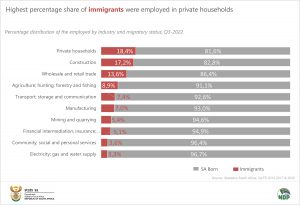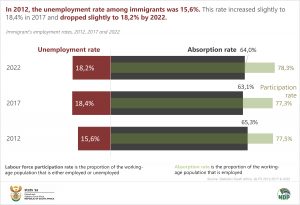Most migrants to South Africa come from the SADC region for employment
Labour migration, the movement of individuals across the borders for employment purposes, is a fundamental aspect of the global economy and has profound social, economic, and political implications. According to the report, Migration profile report for South Africa: A country profile 2023 released by Statistics South Africa (Stats SA), most migrants entering South Africa originate from countries in the Southern African Development Community (SADC) Region.
Results from Census 2022 showed that the SADC region remained the dominant source for international migrants, contributing 83,7% of the total immigrant population. The United Kingdom and Europe region, however, saw a significant decrease, from 22,3% in 2001 to 4,9% in 2022.
The findings on immigration for employment revealed that the proportion of employed immigrants within the overall workforce rose from 6,0% in Q3: 2012 to 8,9% in Q3:2022, while the majority of employed individuals were South African-born persons across the three surveyed period. The highest proportion of immigrants were employed in private households at 18,4%, followed by the Construction (17,2%) and Wholesale and retail trade (13,6%) industries.

Labour migrants are individuals who leave their home countries in search of better employment opportunities, often driven by factors such as poverty, unemployment, political instability, or discrimination. QLFS data indicates that most immigrants in SA moved due to reasons related to family and work.
In 2012, the unemployment rate among immigrants was 15,6%. This rate increased slightly to 18,4% in 2017 and dropped to 18,2% by 2022. The absorption rate stood at 65,3% in 2012 and decreased to 64,0% in 2022.
The labour force participation rate (LFPR), which measures the percentage of the working-age population actively participating in the labour force, was 77,5% among immigrants in 2012. The LFPR decreased slightly to 77,3% by 2017 and increased to 78,3% in 2022, indicating a fluctuation in labour force participation.
Labour migration also presents challenges and risks for both migrants and host countries. Migrants may face exploitation, discrimination, and abuse, including unsafe working conditions, low wages, and violations of their human rights. Labour migration is a complex and multifaceted phenomenon that plays a crucial role in shaping societies and economies around the world. While it offers opportunities for economic advancement and cultural exchange, it also poses significant challenges that require coordinated and comprehensive responses at local, national, and international levels.
Migration profiles are country owned tools developed in consultation with the International Organisation for Migration (IOM). For South Africa, this is the first migration profile compiled together with IOM Regional Office for Southern Africa and the Technical Working Group, which included line ministries, academia, and civil society.
For more information, download the full report here.


